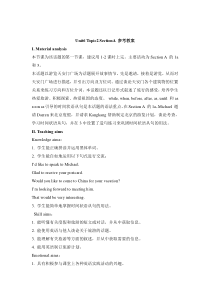 DOC
DOC
【文档说明】Unit 6 Topic 2《How about exploring Tian' anmen Square》(SectionA》word教案-八年级下册英语【仁爱版】.doc,共(8)页,51.500 KB,由小喜鸽上传
转载请保留链接:https://www.ichengzhen.cn/view-104399.html
以下为本文档部分文字说明:
Unit6Topic2SectionA参考教案Ⅰ.Materialanalysis本节课为该话题的第一节课,建议用1-2课时上完。主要活动为SectionA的1a和3。本话题以游览天安门广场为话题展开故事情节,先是邀请,接着是游览,从而对天安门广场进行描述,并引出方向及方位词。通过谈
论天安门各个建筑物的位置关系来练习方向和方位介词。本话题还以日记形式叙述了旅行的感受,培养学生热爱旅游、积极探索、热爱祖国的态度。while,when,before,after,as,until和assoonas引导的时间状语从句是本话题的语法重点。在SectionA
的1a,Michael邀请Darren来北京度假,并请求Kangkang帮助制定北京的游览计划,谈论考查,学习时间状语从句,并在3中设置了造句练习来巩固时间状语从句的用法。Ⅱ.Teachingaims
Knowledgeaims:1.学生能正确拼读并运用黑体单词。2.学生能自如地运用以下句式进行交流:I’dliketospeaktoMichael.Gladtoreceiveyourpostcard.WouldyouliketocometoChinafo
ryourvacation?I’mlookingforwardtomeetinghim.Thatwouldbeveryinteresting.3.学生能简单地掌握时间状语从句的用法。Skillaims:1.能听懂有关度假和旅游的短文或对话,并从中获取信息。2.能使用
英语与他人谈论关于旅游的话题。3.能理解有关旅游等方面的叙述,并从中获取需要的信息。4.能用英语制订旅游计划。Emotionalaims:1.具有积极参与课堂上各种英语实践活动的兴趣。2.培养学生热爱旅游、积极探索、热爱祖国的态度。Ⅲ.Thekeypointsan
ddifficultpointsKeypoints:1.谈论度假和旅游的话题。2.初步掌握时间状语从句的用法。Difficultpoints:掌握when和while引导的时间状语从句的用法。Ⅳ.Learningstrategies善于创设情景,在情景中提高语言交际能力,突显语言交际
功能。Ⅴ.TeachingaidsComputermultimediaprojector,theflashofthesong,IloveTian’anmenSquareofBeijing,apostcard.Ⅵ.Teac
hingproceduresStepInteractionpatternStudentactivityTeacheractivityIntroduction(8minutes)1.Thewholeclasswork.2.Thewholeclasswork.3.Thew
holeclasswork.4.Pairwork.5.Thewholeclasswork.1.Focustheirattentionontheteacher.2.Studentsreadthelettersa
bouttheexperienceoftheirtrip.3.StudentstalkaboutexploringBeijing.Graspthenewword.4.Studentsdiscussthequestions.Giveo
uttheirownopinions.5.Studentsobservethepictureandknowaboutthebackgroundoftheconversation.1.Greetthestudentsandmakethemreadyforlearnin
g.Theteacherplaystheflashofthesong,IloveTian’anmenSquareofBeijing.2.Theteacherasksthestudentstoreportthehomework.Letthestudentsreadthelettersaboutt
heexperienceoftheirtrip.3.TheteachershowssomepicturesofplacesofinterestinBeijing.Leadthestudentstotalkaboutexplori
ngBeijing.Teachthenewwordexplorebyshowingthewordtravel,whichhasthesamemeaning.4.Theteacherletsthestudentsdiscussthefol
lowingquestionsinpairstoleadthelearningof1a:(1)WhatdoyouthinkofBeijing?(2)WhatdoyouknowaboutBeijing?(3)DoyouwanttoexploreBeijing?5.Theteacher
letsthestudentslookatthepictureof1a,andleadsto1abyintroducingthebackgroundoftheconversation.Presentation(10minu
tes)1.Thewholeclasswork.2.Thewholeclasswork.3.Thewholeclasswork.4.Thewholeclasswork.5.Thewholeclasswork.6.Thewhole
classwork.1.Studentswatchtheflashof1atocatchthegeneralideaofthedialogue.2.Studentschecktheiranswerswiththeteacher.3.Studentswatchtheflashforthesecon
dtime,findoutthenewwordsandguesstheirmeanings.4.Studentslearnandgraspthenewwords.5.Studentslistentotherecordingandtickwhattheyhear.
6.Volunteersreporttheanswers.Studentschecktheanswers.1.Theteacherplaystheflashof1a.Askthestudentstoanswerthefollowingquestions:(1)Whe
rewouldMichaellikeDarrentogoforhisvacation?(2)WhichcitywouldKangkanglikeDarrentoexplore?2.Theteacheraskstwostudentstotelltheiranswers
.3.Theteacherplaystheflashagain.Askthestudentstofindoutthenewwords,andguesstheirmeaningswiththehelpofthewordsaround.4.Theteach
eraskstwostudentstotelltheanswers.Teachthenewwordpostcardbyshowingapostcardtothestudents.Teachtheneww
ordreceivebyshowingasituationofgettingaletter.Andteachthewordvacationbyshowingapictureoftravelingaround.5.Theteacherplaystherecordingof1a.As
kthestudentstotickwhattheyhearin1b.6.Theteacheraskstwostudentstotellanswersto1b.Consolidation(10minutes)1.Thewholeclasswork.2.
Thewholeclasswork.3.Groupwork.4.Thewholeclasswork.5.Thewholeclasswork.6.Thewholeclasswork.7.Thewholeclassw
orkandpairwork.8.Thewholeclasswork.1.Studentsreadtheconversationaftertherecordingsentencebysentence.2.Studentstryto
followthespeed,payingattentiontothepronunciationandintonation.3.Studentsreadtheconversationbythemselvesanddi
scussingroupstofindoutthedifficultpointsandsumupthemainpoints.4.Studentsunderlineintheirbooksandmakesomenote
s.5.Studentsfindoutthesentencesaboutinvitation,suggestion,agreementandrequest.6.Volunteerstelltheiranswers.7
.Studentsread1a,graspthenotes,andfindoutthesentencescontainingadverbialclausesoftime.8.Studentschecktheiranswers.Learnandgrasptheusageo
fadverbialclausesoftime.1.Theteacherplaystherecordingsentencebysentence.2.Theteacherplaystherecordingwithoutstopping.3.Theteacherletsthestud
entsread1a,andthenasksthemtolearningroupstofindoutthedifficultpoints.Atlastletthemsumupthemainpointsoftheconversation.4.Theteachermakes
asummarytoexplainthekeypointsanddifficultpointstothestudents:(1)receivethepostcard(2)bebusydoingsth.
(3)(be)onvacation5.Theteacherasksthestudentstofindoutthesentencesaboutinvitation,suggestion,agreementandrequest.6.Theteacherletstw
ostudentstelltheiranswers.7.Theteacherasksthestudentstoread1aandfindoutthesentencescontainingadverbialclausesoftimeinpairs.8.Theteacherasksthestuden
tstochecktheiranswers.Introduceandexplainadverbialclausesoftimebriefly.Practice(10minutes)1.Individualwork.2.Thewholeclasswork.3.Thew
holeclasswork.4.Thewholeclasswork.5.Thewholeclasswork.6.Individualwork.7.Thewholeclasswork.8.Individ
ualwork.9.Thewholeclasswork.10.Individualwork.11.Thewholeclasswork.1.Studentsreadthesentencesof1calone,andnumberthese
ntences.2.Studentschecktheanswerswiththeteacher.3.Studentsreadthesentencesintherightordertogether.4.Studentsretelltheconvers
ation.5.Studentsreadandmatchthesentences.6.Studentschecktheanswers.7.Studentsfindoutmoresimilarexpressionsfrom1a.8.Studentslook
atthepicturesof3,andthenmakesentenceswithwhileorwhen.9.Studentschecktheanswers.10.Studentsskim4.Andknowaboutthewordcampandgraspthephrasewor
kout.11.Studentslistentotherecordingandchoosethebestanswers.1.Theteacherasksthestudentstoreadthesentencesof1caloneandnumberthesentences.2.Theteache
rletstwoorthreestudentstelltheiranswers.3.Theteacherletsthestudentsreadthesentencesintherightordertogether.4.Theteacherletsthestudentsretellthe
conversationbasedonthesentences.5.Theteacherasksthestudentstoreadandmatchthesentences.Finish2.6.Theteacherletstwostudentstelltheiranswers.7.Theteac
herasksthestudentstofindoutmoresimilarexpressionsfrom1aandpracticewiththeirpartners.8.Theteacherasksthestudentstolook
atthepicturesof3,andthenmakesentenceswithwhileorwhen.9.Theteacherletstwostudentswritedowntheiranswersontheblackboard.Checkthea
nswers.10.Theteacherletsthestudentsskimthequestionsandchoicesin4.11.Theteacherplaystherecordingandletsthestudentschoosethebestanswers.Pr
oduction(7minutes)1.Thewholeclassworkandgroupwork.2.Thewholeclasswork.3.Individualwork.1.Studentsdiscussingroupsandfinishthepassage.2.Studentssummari
zeSectionAwiththeteacher.3.Studentsfinishthehomeworkafterclass.1.Theteacheroffersthesituationtothestudents:On
eofyourfriendswillcometoyourhometownonvacation.Makeupaplanforyourfriend,usingtheadverbialclausesoftim
easmuchaspossible.(1)Askthestudentstodiscussthecontentoftheplaningroups.(2)Askthemtowritedownthekeywords.(3)A
skthemtofinishthepassage.(4)Choosearepresentativefromeachgrouptoreporttheirplan.2.Theteachershowsthesummarytothestudents.3.Theteacherassign
shomework:(1)Reviewthesummaryafterclass.(2)Askthestudentstowriteaconversationaboutmakingatelephonecall,usingthewords
while/when.(3)PreviewSectionB.Payattentiontotheexpressionsofdirection.TeachingReflectionThestudentslikeBeijingverymuch.Theyare
interestedinexploringBeijing.Theycangraspthesentencesaboutinvitation,suggestion,agreementandrequestwell.Andtheyunderstandtheusageofadverbialclauseo
ftimeeasily.Ⅶ.BlackboarddesignUnit6EnjoyingCyclingTopic2HowaboutexploringTian’anmenSquare?SectionA1.receivethepostcard2.bebusy
doingsth.3.(be)onvacation4.DarrenwashavingaclasswhileMichaelwasclimbingamountain.5.workout
 辽公网安备 21102102000191号
辽公网安备 21102102000191号
 营业执照
营业执照